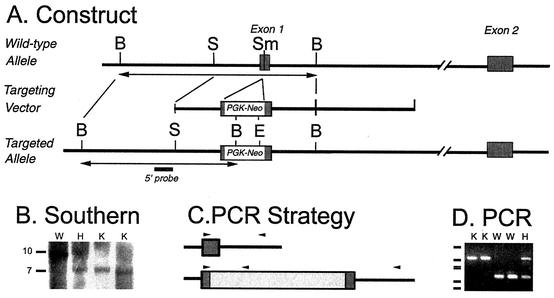FIG. 1.
Mel1b receptor gene, targeting construct, and genotyping strategies. (A) Schematic of the Mel1b receptor gene and the targeting construct. A neomycin resistance gene driven by the phosphoglycerate kinase promoter (PGK-Neo cassette) was inserted in reverse orientation at the SmaI site within exon 1 of the mouse Mel1b receptor gene. The 5′ and 3′ arms of the targeting construct were 2.2 and 7 kb, respectively. (B) Genotyping by Southern blot. A BamHI restriction site introduced with the PGK-Neo cassette formed the basis for genotyping by Southern blotting, using a probe (solid bar in panel A) located outside the 5′ end of the construct. Following digestion with BamHI, the probe hybridizes to a ca. 10-kb band in wild-type DNA and a ca. 7-kb band for the targeted allele. Genotypes are shown above the lanes. Lanes illustrate the hybridization pattern of wild-type (W), heterozygous mutant (H), and homozygous Mel1b-receptor mutant (knockout [K]) mice. Approximate sizes of the genomic fragments are indicated at the left. (C) Strategy for genotyping by PCR. Magnified view of the relationship of the primers (arrows) to the nucleotide sequences of the Mel1b receptor gene and the PGK-Neo cassette. (D) Genotyping by PCR. Amplification of mouse genomic DNA with a cocktail of three primers led to amplification of distinct bands representing the wild-type and targeted alleles. Genotypes are shown above the lanes; designations are as in panel B. Size markers on the left indicate bands at 910, 540, 426, 409, 266, and 166 bp, generated by pUC19 and digested with DdeI.

